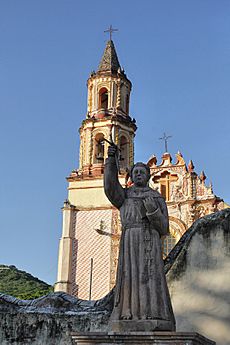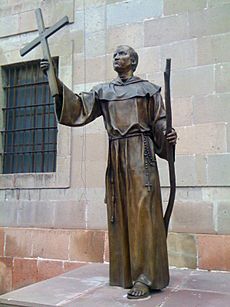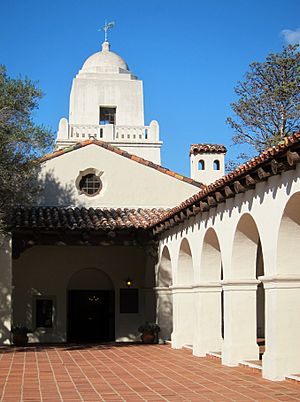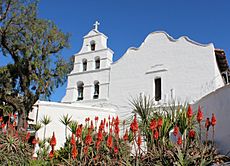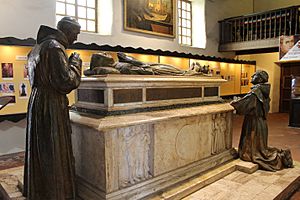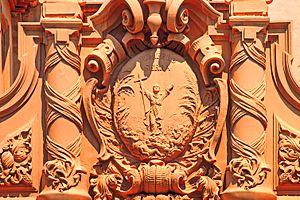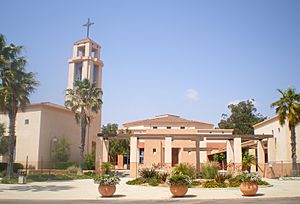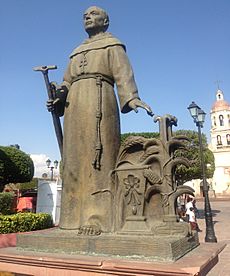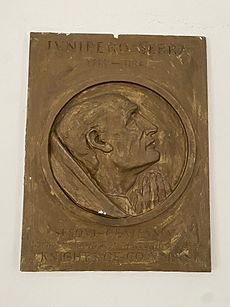Junípero Serra facts for kids
Quick facts for kids SaintJunípero Serra O.F.M. |
|
|---|---|
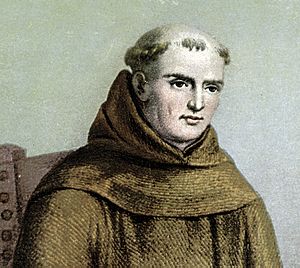
A portrait of Serra
|
|
| Apostle of California | |
| Born | Miquel Josep Serra i Ferrer November 24, 1713 Petra, Majorca, Crown of Aragon |
| Died | August 28, 1784 (aged 70) Mission San Carlos Borromeo de Carmelo, Las Californias, New Spain, Spanish Empire |
| Beatified | September 25, 1988, Saint Peter's Square, Vatican City by Pope John Paul II |
| Canonized | September 23, 2015, Basilica of the National Shrine of the Immaculate Conception by Pope Francis |
| Major shrine | Mission San Carlos Borromeo de Carmelo, Carmel-by-the-Sea, California, United States |
| Feast | August 28; July 1 in United States |
| Attributes | Franciscan habit, wearing a large crucifix, or holding a crucifix accompanied by a young Native American boy |
| Patronage |
|
Junípero Serra y Ferrer (born Miquel Josep Serra i Ferrer; November 24, 1713 – August 28, 1784) was a Roman Catholic priest and missionary from Spain. He was a member of the Franciscan Order. He is famous for starting many missions in what is now California.
Serra helped create the Franciscan Missions in the Sierra Gorda in Mexico, which are now a UNESCO World Heritage Site. Later, he founded missions in Baja California and the first nine of 21 Spanish missions in California. These missions stretched from San Diego to San Francisco. This area was then called Alta California, part of New Spain.
Pope John Paul II declared Serra "blessed" (beatified) on September 25, 1988. Later, Pope Francis made him a saint (canonized him) on September 23, 2015. This happened during the Pope's first visit to the United States. Serra is often called the "Apostle of California" because of his missionary work.
Contents
Early Life and Calling
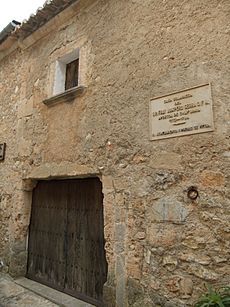
Junípero Serra was born Miquel Josep Serra i Ferrer in the village of Petra. This village is on the island of Mallorca in the Balearic Islands, off the coast of Spain. His parents were Antonio Nadal Serra and Margarita Rosa Ferrer.
From a young age, Miquel helped his parents work in the fields. But he was very interested in visiting the local Franciscan church of San Bernardino. There, he learned to read, write, and sing church music. He had a good voice and enjoyed singing with the friars.
At 16, Miquel went to a Franciscan school in Palma de Majorca to study philosophy. A year later, he decided to join the Franciscan order.
Joining the Franciscans
On September 14, 1730, just before his 17th birthday, Serra officially joined the Franciscan Order in Palma. He chose the religious name Junípero, honoring an early companion of Francis of Assisi. As a novice, he prepared to become a full member of the order. He promised to live simply and without owning much.
He spent seven years studying logic, philosophy, and theology. His daily life was strict, with prayers, meditation, and chores. He enjoyed reading stories about Franciscan friars who traveled the world to spread their faith.
In 1737, Serra became a priest. Three years later, he taught philosophy at the Convento de San Francisco. Among his students were future missionaries Francisco Palóu and Juan Crespí. Serra was known for being very smart. He earned a doctorate in theology and taught at a special college for missionaries.
In 1748, Serra and Palóu decided they wanted to become missionaries. Serra, then 35, gave up a respected career in Majorca to focus on spreading his faith in new lands. They received permission and sailed to Cádiz, Spain, to prepare for their journey to the Americas.
Missionary Work in the Americas
In 1749, Serra and other Franciscan missionaries arrived in Veracruz, Mexico. They traveled to Mexico City on the Camino Real, a long, difficult road. Serra chose to walk the entire way, following the rules of his order, even though horses were offered.
During this walk, Serra's left foot became very swollen and itchy. He scratched it so much that it bled. This injury bothered him for the rest of his life.
In Mexico City, Serra joined the College of San Fernando de Mexico, a training center for missionaries. Despite his high education, he chose to live simply, like a new student.
Missions in the Sierra Gorda
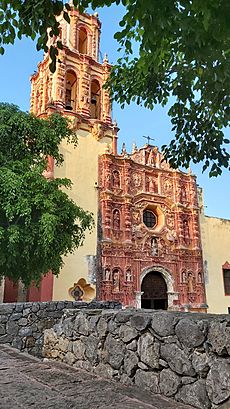
Serra and Palóu were sent to the Sierra Gorda region, about 90 miles north of Santiago de Querétaro. This area was home to the Pame people. When they arrived at the village of Jalpan, the mission was not doing well.
The missionaries learned the Pame language to communicate. Serra also involved the Pame people in religious ceremonies. He led processions, carrying a heavy cross, and preached about Jesus. He also washed the feet of 12 Pame elders, like Jesus did with his apostles.
Serra also helped with the practical needs of the mission. He brought cattle, goats, sheep, and farming tools. The mission residents learned skills like spinning and sewing. They sold their extra goods in nearby towns, with the friars making sure they were treated fairly. Pames who adapted well received their own land to farm.
Serra worked to change the Pames' traditional beliefs. In 1752, he brought a statue of a goddess, given to him by Christian Pames, to Mexico City. This showed his progress.
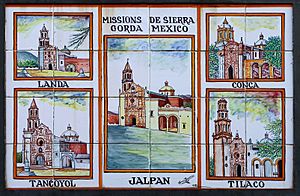
Serra also helped protect the Pame people from Spanish soldiers and settlers. The soldiers were trying to claim mission lands. Serra and his college supported the Pames, citing Spanish laws that protected mission territories. After a long legal fight, the settlers moved, and the Pames kept their land.
Serra oversaw the building of a beautiful church in Jalpan. He brought skilled workers from Mexico City and employed Christian Pames. Serra even helped with the construction himself, carrying beams and applying mortar.
Work for the Inquisition
In 1752, Serra was appointed an inquisitor for the Sierra Gorda region. This meant he had the power to investigate certain religious matters. He reported on "witchcraft" in the missions, focusing on non-Indians.
Serra also worked in other parts of Mexico as a missionary and inquisitor. In 1758, he returned to the College of San Fernando and worked in administration and as a missionary in various areas.
Personal Devotion
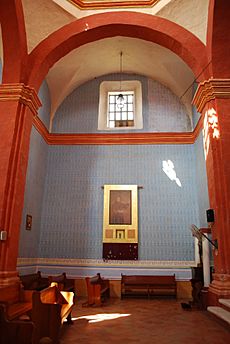
Serra was very devoted to his faith. He believed in physical self-discipline to purify his spirit. He sometimes wore uncomfortable clothing under his friar's robe. He also kept a chain in his cell to remind himself to be humble.
During his sermons, Serra would sometimes use dramatic actions to encourage people to reflect on their actions. He would speak passionately about faith and repentance.
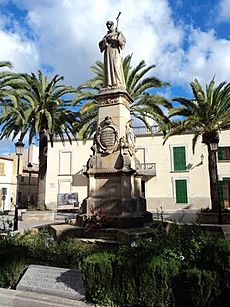
Serra's actions were part of a tradition among some zealous missionaries of his time. They believed such displays helped to inspire their listeners.
Jesuits Expelled from Mexico
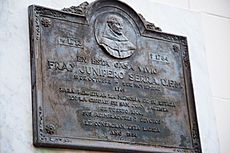
In 1767, King Carlos III ordered the expulsion of Jesuits from all Spanish lands. This meant Jesuit missionaries had to leave their missions.
In Baja California, Governor Gaspar de Portolá had to remove the Jesuits from the missions they had built. He treated them kindly, but they had to leave.
President of Missions in the Californias
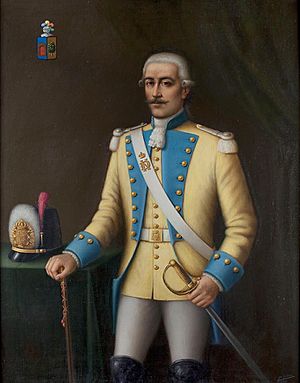
After the Jesuits left, Franciscan missionaries took over. In July 1767, Serra was chosen to lead the missions in Baja California. He led a group of 15 Franciscan friars, with Francisco Palóu as his second in command.
In March 1768, Serra and his team sailed to Loreto. Governor Portolá welcomed them. At first, the Franciscans only controlled spiritual matters, while the military managed daily life. But later, the missions were fully given to the friars.
The native population in Baja California missions had decreased significantly due to diseases. Serra and his fellow friars were concerned about this decline.
In 1768, José de Gálvez, a Spanish official, decided to explore and establish missions in Alta (upper) California. This was to Christianize the native people and protect Spanish interests from other countries. Gálvez chose Serra, then 55, to lead the missionary team. Serra was eager to convert new souls.
Despite his painful foot and leg infection, Serra insisted on joining the expedition. He refused to turn back, even if it meant dying on the way. He believed God would give him the strength.
Serra traveled with two servants and a mule. His journey was difficult due to his leg. A muleteer helped him by applying a special remedy, which made his leg feel much better.
The expedition traveled about 300 miles to San Diego. They saw the Pacific Ocean and met friendly native people along the way. Serra was very fond of these people.
Arrival in San Diego
On July 1, 1769, Serra's group arrived in San Diego. They met up with other parts of the expedition that had arrived by sea. Many men had suffered from illness and dwindling food supplies during the journey.
On July 16, 1769, Serra founded Mission San Diego. This was the first of the California missions. It was built in a simple shelter on Presidio Hill.
Early on, there were tensions with the local Kumeyaay people. They were interested in Spanish goods but sometimes clashed with the soldiers. An attack by a group of over 20 native people resulted in injuries on both sides. Serra's young servant was killed.
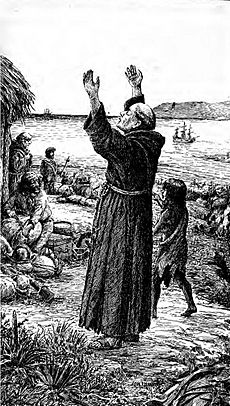
Serra tried to convert the Kumeyaay. He hoped to baptize a child, but the parents took the baby away at the last moment. For months, no native people were converted at Mission San Diego.
Food became scarce. Governor Portolá planned to leave San Diego if a supply ship didn't arrive by March 19, 1770. Serra was very worried. On that day, a ship, the San Antonio, appeared on the horizon, bringing much-needed supplies.
Journey to Monterey
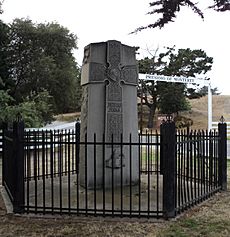
With new supplies, Portolá and his men decided to go north to Monterey. Serra sailed on the San Antonio, while Friar Juan Crespí went by land. Serra felt lonely, but trusted in God.
The sea journey was difficult due to strong winds. Many sailors got sick. Meanwhile, the land expedition reached Monterey Bay on May 24, 1770, without any serious problems.
On May 31, the San Antonio arrived in Monterey Bay, reuniting the groups. On June 3, 1770, Serra, Portolá, and the expedition held a ceremony to found Mission San Carlos Borromeo. They sang, raised a cross, and fired guns and cannons.
Serra soon realized the mission needed to be moved. There were no native villages close by, which was against the rules for missions. He wanted to move it to Carmel, which had better land and water.
Missions Founded
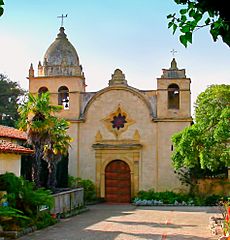
Serra stayed in San Diego to start Mission San Diego de Alcalá, the first of 21 California missions. He then moved to Monterey in 1770 and founded Mission San Carlos Borromeo de Carmelo. This mission later moved to Carmel and became his main base.
Under Serra's leadership, the following missions were founded:
- Mission Basilica San Diego de Alcalá, July 16, 1769, in San Diego.
- Mission San Carlos Borromeo de Carmelo, June 3, 1770, in Carmel-by-the-Sea.
- Mission San Antonio de Padua, July 14, 1771, near Jolon.
- Mission San Gabriel Arcángel, September 8, 1771, in San Gabriel.
- Mission San Luis Obispo de Tolosa, September 1, 1772, in San Luis Obispo.
- Mission San Juan Capistrano, November 1, 1776, in San Juan Capistrano.
- Mission San Francisco de Asís, June 29, 1776, in San Francisco.
- Mission Santa Clara de Asís, January 12, 1777, in Santa Clara.
- Mission San Buenaventura, March 31, 1782, in Ventura.
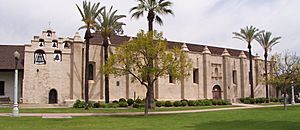
The main goal of the missions was to teach the native people about the Catholic faith. They also aimed to help them adapt to Spanish society and become a productive workforce. The missions were important for Spain to control the region.
In 1773, Serra traveled to Mexico City to resolve issues with the military commander, Pedro Fages. Serra successfully argued for Fages' removal. He also worked to protect the rights of native people in the missions.

Franciscans believed that native people deserved a chance for salvation. Converted native people were encouraged to live at the mission. They learned new skills like farming and carpentry. While discipline was strict, the missions also provided a stable community and resources.
Serra's missions were important for the economy of California. They produced food and goods, which helped the colony survive and even trade with Mexico.
In 1779, Franciscan missionaries, led by Serra, planted California's first lasting vineyard at Mission San Diego de Alcalá. This is why Serra is sometimes called the "Father of California Wine".
Treatment of Native Californians
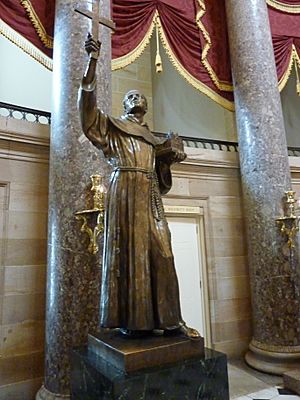
From Serra's point of view, his main goal was to help the native people find salvation through Christianity. He saw himself as a father figure to them. He believed that some forms of punishment were acceptable to guide them, as was common at the time.
Serra also worked to protect native people from abuse by Spanish soldiers. He protested against Governor Pedro Fages when soldiers mistreated the native population. Serra's efforts led to rules that protected native people under the missions' care. These rules recognized them as "Children of God" with certain rights.
Support for Canonization
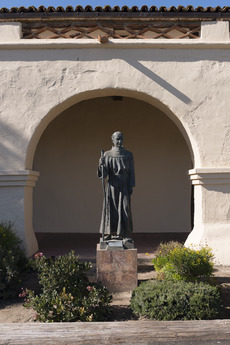
Despite some concerns about the treatment of native people, many Native Americans in California today are Catholic and supported Serra's canonization. For example, James Nieblas, a Native American priest from a tribe evangelized by Serra, supported his sainthood.
Members of other tribes also expressed support. Tony Cerda, chief of the Costanoan Rumsen Carmel tribe, stated that their ancestors were buried at Mission Carmel and they supported the canonization.
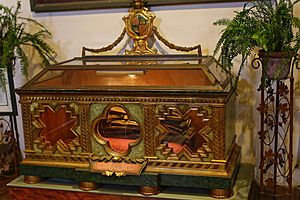
During Serra's canonization Mass, two members of California's Ohlone Tribe participated. Andrew Galvan, an Ohlone tribal member and curator of Mission Dolores, saw the canonization as a significant moment for native people.
Ruben Mendoza, an archaeologist of Mexican and Native Yaqui descent, has studied the missions. He believes Serra worked hard to evangelize native Californians and helped create modern California.
Death and Legacy
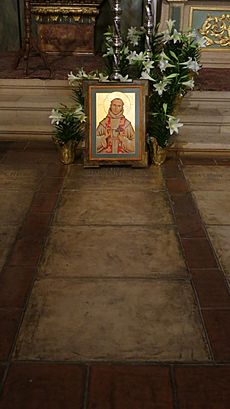
In his last three years, Serra visited missions from San Diego to San Francisco, traveling over 600 miles. He confirmed 5,309 people, mostly California native converts. He suffered from his leg and chest but refused remedies.
Junípero Serra died on August 28, 1784, at age 70, from tuberculosis. He is buried at Mission San Carlos Borromeo de Carmelo under the sanctuary. After his death, Fermín Lasuén took over leadership of the Franciscan missions in Alta California.
Veneration
Junípero Serra was beatified by Pope John Paul II on September 25, 1988. The Pope praised Serra for spreading Christian faith during a time of great change.
Serra was canonized by Pope Francis on September 23, 2015. This was the first time a canonization happened in the United States. Pope Francis called Serra "one of the founding fathers of the United States."
Serra's feast day is July 1 in the United States and August 28 elsewhere. He is considered a patron saint of California, Hispanic Americans, and religious vocations.
His burial place at Mission Carmel is a place of public respect. His grave is marked in the floor of the sanctuary. Other items belonging to Serra are displayed in the mission museums.
Legacy and Monuments
Many of Serra's letters and writings still exist today. The Santa Barbara Mission Archive-Library holds many of his early documents.
The chapel at Mission San Juan Capistrano, built in 1782, is thought to be the oldest standing building in California. Serra celebrated religious services there.
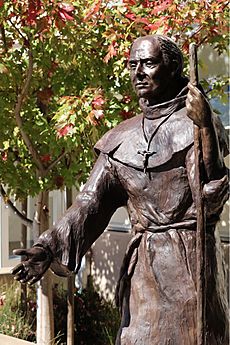
Many places in California are named after Serra. These include streets, schools, and even a mountain. Examples are Junipero Serra Boulevard in San Francisco and Serra Mesa in San Diego. Several high schools also bear his name.
Both Spain and the United States have honored Serra with postage stamps. In 1884, California made August 29, the 100th anniversary of his burial, a legal holiday.
Serra International, a global Catholic organization, is named in his honor. It works to promote religious vocations.
Serra's legacy regarding Native Americans has been a topic of discussion. Some groups have protested his canonization, while others, including some Native Americans, have supported it.
In 2015, the San Carlos Borromeo de Carmelo Mission was vandalized. A statue of Serra was toppled, and messages were painted on his tomb. Law enforcement investigated this as a hate crime.
In 2019, Stanford University renamed two buildings that had been named after Serra.
Statues and Monuments
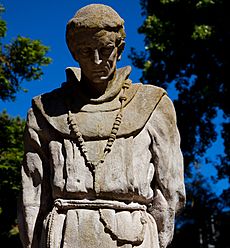
- A statue of Junípero Serra represents California in the National Statuary Hall Collection in the United States Capitol.
- The statue of Serra in Ventura, California, was displayed in front of Ventura City Hall for many years. In 2020, it was moved to storage.
- The Douglas Tilden statue of Serra in San Francisco's Golden Gate Park was toppled in 2020 during a protest.
- A granite monument to Serra was erected in Monterey in 1891.
- Interstate 280 in California is named the Junipero Serra Freeway. A statue of Serra stands on a hill beside it in Hillsborough, California.
- Statues of Serra are found on the grounds of several mission churches, including those in San Diego and Santa Clara.
- A bronze statue of Serra in California State Capitol's Capitol Park was toppled by protestors in 2020.
- A statue of Serra is located in the courtyard of Mission Dolores in San Francisco.
- A statue of Serra near the San Fernando Mission in Los Angeles was vandalized in 2017.
Images for kids
-
The Vizcaíno-Serra Oak, in Monterey, where Sebastián Vizcaíno celebrated mass in 1602 and Serra celebrated mass in 1770.
-
Mission San Francisco de Asís, founded in 1776.
See also
 In Spanish: Junípero Serra para niños
In Spanish: Junípero Serra para niños
- Junípero Serra Museum
- Vizcaíno-Serra Oak
- Saint Junípero Serra, patron saint archive



